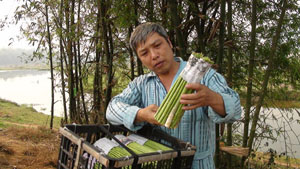


(HBO) – Farmers in Nam Thuong commune (Kim Boi district) are increasing investment in cultivating a number of key crop plants, including asparagus which brings high economic value.
|
The commune is home to 5 ha of asparagus, mainly in Boi Ca and Bai Xe hamlets. Thanks to planting asparagus, households in the commune earn hundreds of millions of VND a year. The family of Bui Van Nghia and Bui Thi Phuong in Boi Ca hamlet is the pioneer in cultivating asparagus in the locality. In July 2015, the couple spent about 250 million VND on seedlings and irrigation systems.
Before embarking on the project, they studied documents and growing techniques on television, and visited asparagus cultivation areas in Hanoi. Through research, they got to know that this plant requires meticulous and strict planting techniques.
Mr. Bui Van Quy in Bai Xe hamlet, Nam Thuong commune (Kim Boi district) is checking the quality and packing specification of the product before delivery.
From what they learnt, Nghia’s family decided to convert the ineffective potato and rice cultivation area into an asparagus farm. After growing for about 5-6 months, the plant is able to be harvested. Good care can result a good harvest of five years.
In the
meantime, Nghia’s family has asparagus for daily sale. Every day, the family harvests
about 30-40 kg of asparagus/ha on average, helping it rake in about 200
million VND a year. Apart from
Nghia’s family, many other households in Bai Xe hamlet are also getting rich
from growing asparagus.
Quy said his family harvests about 20kg of asparagus a day and those are purchased by Dung Ha Farm Produce Co., Ltd in Hanoi.
"My family makes a monthly profit of between 25-30 million VND from the model,” Quy said.
|
Vice Chairman of the Nam Thuong communal People’s Committee Bui Van Chu affirmed planting asparagus brings an income of 10-20 times higher than planting other crop plants. However, initial investment in asparagus cultivation is also very high and it requires strict growing techniques, he noted.
Thanks to the high economic value and stable market, asparagus helps local farmers earn at least 100 million VND a year, he said./.